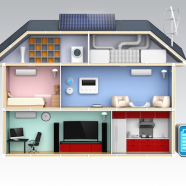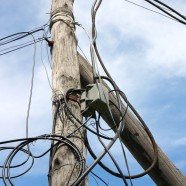5 Great Bathroom Lighting Ideas
When it comes to choosing rooms to remodel, bathrooms are always near the top of almost every homeowner’s list. Families grow, styles change, and fixtures seem to look dated quicker than in other parts of the house, so bathroom renovation is a natural choice after just a few years.
After you’ve decided on the bathtub and the color scheme, consider how lighting can become the final touch that brings the room together. Nothing completes a room like the right lighting scheme, and few decorating accents can do so much with such a small amount of effort and money.
Layer the Light
If your bathroom lighting consists of one fixture in the middle of the ceiling, you’re in desperate need of an upgrade. While a single ceiling light might give you enough light to shower by, it doesn’t do anything for the look of the room. Task lighting will give you layers of light while adding warmth to the space. Put in a light above the shower or bath, flank the dressing mirror with side lights, and even add tiny lights along the bottom of the wall to stand in for old-fashioned night lights.
Use Non-Traditional Lighting
A complete bathroom renovation calls for a complete rethinking on your lighting scheme. Why stick with traditional bathroom ceiling lights in your sleek new room? Consider other types of light sources to give your bathroom a unique designer look while lighting up the space. Try bean pot lamps or candlestick lights on a side table, hanging kitchen lights over the vanity, or small electric candles through the room for a soft, romantic glow.
Vanity Lighting
If your bathroom design doesn’t leave much room for dedicated vanity lighting, add light sconces directly onto the surface of the mirror. The mirror behind the lights will double the brightness, giving the room twice as much light in a very small space.
Lighting as Decor
Bathroom lighting doesn’t have to be a simple utility. When you choose the right fixtures, the lighting can become a crucial part of your bathroom design:
- Sleek, modern rooms look great with lots of chrome lamps and fixtures.
- If your design flair leans toward the funky, incorporate strings of rope lighting wound around the curtain rods.
- For a room that is romantic and ruffled, bring in some bedside lamps and candle sconces to continue the theme.
- If this bathroom is mainly for the kids, use lamps in bright primary colors, or check the bedroom department for colorful lamps with their favorite cartoon characters on them.
You may have to change things out as your (or the kids’) interest wanes, but then it will give you a good excuse to give the room a makeover.
Use Multiples
When it comes to bathroom lighting, if one is good, then many are better. Plan a design that includes multiples of all the lights you plan to install. Instead of one central light fixture, install three or five hanging bulbs with decorative shades on different lengths of cord. Group bunches of electric candles on the back of the toilet. Use multiple small bulbs around the vanity mirror instead of one or two smaller ones. More always looks rich and abundant, and it takes your room away from the cookie-cutter design look.
Some lighting changes are a snap to do on your own, but some require a licensed professional electrician to install them safely. When you speak with your electrical contractor and plan your bathroom renovation, let him know about the lighting designs you want to use so he can incorporate them into his renovation schedule.
Read MoreReasons to Choose Remote Monitoring for Your Standby Generator
People living in areas that are subject to frequent power outages (such as southeastern Florida) know the importance of having a standby generator installed in their home.
Between frequent lightning storms, older infrastructure, and the risk of tropical storms, all local homes can use a whole-home generator. But if your generator isn’t working when the power goes out, it’s a waste of space in your yard.
The best way to keep up with the state of your backup power supply is by using generator monitoring.
Testing
If you count on your standby generator for peace of mind during thunderstorms and power outages, you need to take every precaution to make sure it’s going to work when the power goes out.
How do you know when your whole-home generator is working correctly? Good generator monitors will test your unit weekly, turning it off and then on again. If anything is wrong the standby generator won’t go back on again, much like an electric light won’t go on if the circuit breaker has been tripped.
Once the monitor sends you a signal telling you that there’s a problem with the generator, you can repair it before the machine is needed during the next power outage.
Remote Alerts
Some generators give off an alarm when something is wrong, but if you’re not home, or if your air conditioning unit is too loud you may not hear anything before it’s too late.
With generator monitoring, the smart sensor on your machine checks on a regular basis, or checks constantly, and will send you a message if something is wrong.
You can choose to get a recorded phone call, a text message on your phone or an email, depending on the monitoring company you employ.
Fuel Level
You can monitor your system all day long, but if your power supply doesn’t have fuel it won’t work during a blackout. The fuel level in your standby generator is probably one of the last things you think to check every week, but you can have a monitor check it for you.
Some generators have level checks built in and you can have alerts sent to your phone or email. If your generator doesn’t include a fuel check, you can install one very easily, then synch it with your monitor. You’ll always have a full generator, and one less thing to have to worry about.
Vacation Peace of Mind
Installing a whole-home generator adds a great deal of peace of mind when you’re on vacation, but to be completely sure your home will still be in good shape when you come back, a monitor is best. If the power goes out while you’re in another state and the generator doesn’t go on, the message you receive can give you time to call a neighbor or friend to add fuel or remove your frozen food before you can get back home.
You can take your family on vacation secure in the knowledge that your belongings will be just as you left them when you get back.
Health Concerns
For most people, keeping the power on is a convenience issue, but for those with health problems it can be literally life or death:
- Diabetics who take insulin have to keep their supply in a cold storage place or it will go bad.
- Patients with breathing problems need to run CPAP machines or breathing treatments.
- Even electric carts and wheelchairs have to be recharged on a regular basis, making a standby generator a crucial element in day-to-day health care.
If you or your family members need electricity to keep yourself healthy, generator monitoring can be a crucial part of protecting your health.
Read MoreHow to Prevent Problems from Overloaded Circuits
It’s not likely that your house will catch on fire from one tripped circuit breaker, but frequently overloaded electrical circuits can become a dangerous situation if they’re not corrected. Power surges are common in Florida because of the frequent electrical storms in the area, and any circuit that’s running up to capacity is in danger of overloading every time lightning strikes in the area. Preventing problems with your electrical equipment is a matter of preparing ahead of time, then keeping up with the quality of your equipment rather than letting it fall into disrepair.
Audit Your Equipment
If you’ve been tripping circuit breakers or if you have lights that dim when the refrigerator comes on, you know where the problems are in your house. Not having these problems doesn’t mean your electrical equipment is perfectly fine, though. Circuits may be running just on the edge of their limits, and one storm or an extra appliance being plugged in can be just enough to push them over the edge.
If you don’t have a circuit map of your home, take the time to create one of your own. Turn one breaker off, then move through the house and see what lights, outlets, and equipment doesn’t work. Mark that area on the map and indicate what breaker it’s connected to, then move on to another breaker. Map out your entire house in this manner.
Go through each individual circuit and unplug any appliances that aren’t currently in use. If you make coffee once a day, unplug the pot when you’re ready to head out in the morning. Work all day long? You don’t need the television plugged in, draining power while you’re gone. From phone chargers to blow dryers, most houses have dozens of items plugged in and draining power. Lighten the load on your circuits by unplugging yours.
Upgrade Your Electrical Installation
The equipment in your house uses electrical services in the most efficient way it can, but if you’re overloading the system, it’s probably time to upgrade and replace your older electrical equipment. The most obvious clue that you need an upgrade is having an older house with a fuse box instead of circuit breakers. Call an electrical contractor to replace this immediately, as older fuse boxes are almost invariably worn out, creating a fire hazard in your home.
If you’re constantly having to unplug appliances just to plug something else in, or if you’re relying on power strips and extension cords as a permanent solution, you need an upgrade on wiring and outlets. Adding outlets in logical places depending on your electrical usage can help to spread the load, but you may need additional upgraded wiring if your usage is heavy in one part of the house such as an office with multiple computers and large monitors. Your contractor will test your lines and tell you if you need an upgrade.
Schedule Regular Maintenance Appointments
Electrical maintenance isn’t just for repairing problems once they’ve happened. The best and least expensive way to deal with electrical problems is to prevent them before they happen. Scheduling regular maintenance appointments with an electrical contractor will eliminate most of the problems you have with wiring and circuits in your home. An electrical contractor will check wiring for wear and excess usage, look for possible improvements in your system, suggest ways to save power, and replace any equipment that’s beginning to wear out. You schedule regular dental and medical checkups for yourself; give your home the same consideration and have your electrical contractor check your wiring a couple times a year.
Read More



Recent Comments